ORIGINS
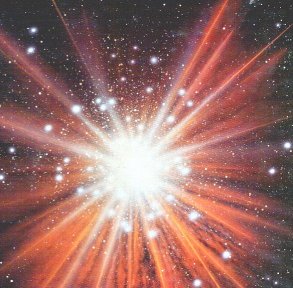 Stellar evolution
is very well understood.
Stellar evolution
is very well understood.
Thirteen trillion years ago, more or less, there was the Big Bang.
We'll ignore what came before and what will come in the distant future
as these events are currently irrelevant, though very interesting.
But energy was released! Energy formed into quanta and quanta
into sub-atomic particles which formed into atoms, mostly Hydrogen.
(note that I am being VERY simplistic here for the audience, most of whom
are not astronomers)
These Hydrogen atoms collected into clouds which collapsed into balls
under the pressures of gravity.
If the ball was large enough, the pressure of gravity forced the internal
temperature to rise with the depth of the compression.
If the ball of Hydrogen was large enough, the internal temperature rose
into the millions of degrees and suddenly! Nuclear Fusion took place.
That ball of Hydrogen became a gigantic Hydrogen Bomb… a Star was born.
As the Hydrogen burned, it created a waste product.. Helium! Some
of which sank to the center of the star.
If the star was large enough, the internal pressure caused by gravity
caused the temperature to rise enough to burn Helium and you now have a
Helium Bomb inside the Hydrogen Bomb that is the star. And when Helium
burns, it produces Lithium.
You get the idea so we'll skip the next few steps. Check the periodic
Chart of the Elements to see how this goes. Each element creating
a heavier element as a by-product of Nuclear Fusion.
If the star is large enough and lives long enough, the Iron that is
now in the center burns. But Iron doesn't burn like Hydrogen or Helium,
it burns like a firecracker and that very large star becomes a Super-Nova!
And when a Super-Nova explodes, matter is ripped apart and reformed.
Heavy elements are created from lighter. Lead, Gold, Silicon, Uranium,
Quasimodium. Ok, I made that last one up but of the hundred and dozen
known elements, more are being created almost yearly someone, someday will
create/discover a new element that they will call Quasimodium because of
its properties and I'll get no credit. The point is that these hydrogen
clouds are now filled with more than just hydrogen.
 Eventually, in
the less fashionable spiral arm of the Milky Way Galaxy, a star formed.
Eventually, in
the less fashionable spiral arm of the Milky Way Galaxy, a star formed.
As stars go it wasn't remarkable. It had an average mass and formed
in the normal way. A passing stellar object or maybe a Galactic Gravity
Wave caused a cloud of mostly-Hydrogen-with-a-lot-of-other-elements to
swirl and then form into a ball which collapsed under gravity. As
that ball spun, the heavier elements were tossed outward into a disc while
the central part turned into a star!
The disc did its own thing. Atoms collected and attracted other
nearby atoms until something resembling the Rings of Saturn formed about
this Star that hadn't yet finished starting a nuclear reaction. As
these balls of matter traveled, they picked up everything in their path,
then attracted nearby matter until planets formed (we are still skipping
steps because I don't want to bore you but if you insist I can expand this
part to a dozen pages that reads like Dos for Dummies).
Then the Star erupted in a massive Hydrogen Explosion that cased a pressure
wave that cleared out almost everything that wasn't too heavy to push.
The results were a number of planets and a bunch of moons. Some formed
with the planets, some stolen from other places.
Now here is where it gets interesting. Life!
LIFE
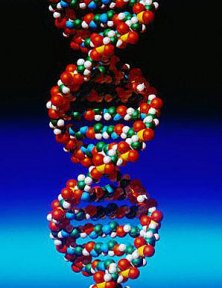 Life can be
created from a number of materials in a number of ways. Hydrogen
life requires cold empty space. Helium Life requires a temperature
of almost absolute Zero but a planetary surface! (It's kinda neat
to fill a bottle with helium then drop the temperature to -273 degrees
and watch that helium come to life) Silicon life and Carbon life
are common but each form of life requires a different circumstance.
The atmosphere of Jupiter is perfect for Silicon Life but not carbon life,
as is the subsurface of Earth which is inhabited by myriads of species
of silicon life. I have some in my house if you are interested and
found a breeding colony of silicon life in an isolated bay on Canyon Lake
in Arizona. But I digress.
Life can be
created from a number of materials in a number of ways. Hydrogen
life requires cold empty space. Helium Life requires a temperature
of almost absolute Zero but a planetary surface! (It's kinda neat
to fill a bottle with helium then drop the temperature to -273 degrees
and watch that helium come to life) Silicon life and Carbon life
are common but each form of life requires a different circumstance.
The atmosphere of Jupiter is perfect for Silicon Life but not carbon life,
as is the subsurface of Earth which is inhabited by myriads of species
of silicon life. I have some in my house if you are interested and
found a breeding colony of silicon life in an isolated bay on Canyon Lake
in Arizona. But I digress.
But Carbon forms life only under certain conditions. And for a
star the size of Sol, those conditions exist only around 90 million miles
out. Give or take 10%. Too close to the Star and the temperature
is too hot for carbon to form living molecules. Too far out and the
temperature is too cold to form living molecules. So you need a planet
about 90m miles from a Sol-sized star to form carbon-based life.
And not just any planet, a stony-iron planet! Were Jupiter in
the position of Earth, life, silicon or carbon, would never form.
So Earth got lucky. A stony-iron world at the right distance from
the right-sized star to be at the right temperature.. and about 4.5 billion
years ago, Earth formed. About a billion years later, carbon-based
life appeared.
Early life was basically red-algae and green-algae and both happily
coexisted… until they met and war ensued.
This was not organized warfare with algae-created weapons… no, it was
simply a matter of which algae found the best food so it could reproduce
faster than the other. On Earth, Green-Algae won so life here is
based on Green Algae!
And you know the rest! Evolution spawned DNA which recombined into microbes
and fish and lizards and dinosaurs and people until the pinnacle of evolution
was evolved.. the Redheaded Red Sonja Cos-Player in a chain mail bikini.
Oops, wrong group.
MARS
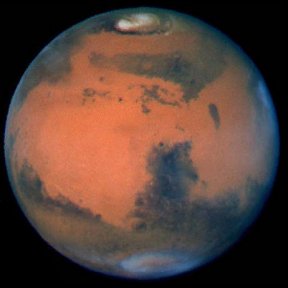 Mars got short-changed.
Mars got short-changed.
At 135 million miles out, it was too cold for carbon to form life.
And so while the dinosaurs were happily breeding into fantastic shapes
to screw with the Creationists-to-be, Mars was dead!
Then, some 50 million years ago, long after the dinosaurs were safely
gone from the surface of the Earth and long before Megalodon evolved to
terrorize future movie-goers, Mars got a break.
A very large hunk of rock was moving through space and Mars got in the
way! It happens a lot! The Astronauts reported that they
saw dozens of massive rocks strike the Earth's atmosphere and, fortunately,
explode instead of push to the surface.
But some hunk of rock hit Mars near the South Pole and the result was
the Argyre Planitia. Not the largest impact crater by far but one
of vast importance.
Striking about 50 million years ago (give or take), the impact was amazing.
Rocks the size of cities were tossed into space, some to return, some to
leave forever, some to reach Earth. The ejecta formed a ring crater
thousands of feet high and a hole that neatly punched through the crust.
The impact caused fractures that crossed half the planet and the ejecta
landed to form more craters. The heat from the impact was unbelievable
and carbon dioxide, frozen at the poles, vaporized to settle as free carbon
and oxygen.
Carbon requires a certain set of environmental circumstances to form
life. Earth met those and life took its time evolving. Mars
had none.. until the Argyre impact created a temporary eco-system that
allowed carbon to do its thing.
Suddenly life exploded. It didn't have much time so evolution
ran wild! Red Algae won the initial war and became the dominant life
on Mars. Lacking a viscous ferrous core, Mars had no Van Allen belts
to slow the hard solar radiation that burned the surface. Solar Radiation
caused DNA to recombine faster than it did or could on Earth with her protection
of the Ozone Layer, the Van Allen Belt and the thick atmosphere.
Billions of years of evolution happened in a few millions of years.
BUT…..
The simple facts of cosmology are well understood. Drop a rock,
it falls down. As the system becomes complicated, so do the results.
Drop a rock near a mountain and the rock may fall down, but not straight.
The mountain attracts that rock. Move fast and you get heavier and
(from my view) move slower until you freeze in time as you approach the
speed of light. The universe, based on simple laws, gets drastically
more complicated as more and more things interact.
The Argyre Crater became a hotbed of evolutionary experimentation.
Simple life, algae, ferns, moss, spread easily over the planet to take
advantage of the temporary atmosphere created by the impact, and once established,
life ensured its own existence. The moss and algae maintained the
atmosphere as best it could. The impact reformed the gasses into
water and the Five Great Seas formed. Although this happened over
millions of years, by cosmological time, the interval between the Argyre
Impact and today was a blink of the eye. A temporary aberration on
a dead planet. BUT one of which that life took advantage. Yes,
the Mars of today is dying, but it was never meant to live so is returning
to its natural state.
BARSOOM
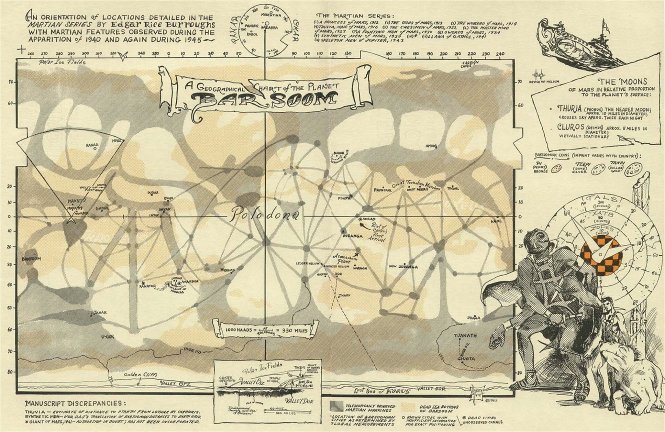 So now, thanks to one small planet getting in the way of a very large rock,
a temporary eco-system formed that was perfect to create and sustain life,
…. for a couple dozen million years.
So now, thanks to one small planet getting in the way of a very large rock,
a temporary eco-system formed that was perfect to create and sustain life,
…. for a couple dozen million years.
25 million years after the Impact, scarlet moss and red ferns and even
a few red-leafed trees cover the planet. Five Great Seas have formed
with multiple rivers and lakes. Fissures become rivers and impact
craters become lakes or havens for life. Plants are having a field
day. Then one plant is bombarded with solar radiation at the wrong
time and the Tree of Life forms!
Now animal life appears. Animals from plants? Where do you
think we came from? Green algae! Some scientists will insist
that 23 million years is too short of a time for evolution to colonize
an entire world in such advanced diversity. But John Carter said
it best when he commented that some scientist will produce reams of paper
to prove that Mars is inhabited only to be confronted by another scientist
the next day with reams of paper to prove that Mars is dead. We see
this daily. Mainstream biologists laugh at cryptozoologists even
when the crypto people prove again and again that they are right and extinct
species still exist or unknown monsters walk the earth. One day the
best physicists prove that it is impossible for man to survive speeds of
60 mph.. until someone rides in a locomotive that exceeds that and survives.
Scientists insist that the ‘guy died before he hit the ground’ because
the velocity of a man's fall will kill him long before the impact.. until
skydivers prove him wrong. Evolution was ‘quack science’ until long
after Darwin. Then evolution was slow and gradual.. until it was
discovered that evolution can happen in spurts that happen over a few generations.
So for a plant to produce animals over a few million years on a FOREIGN
planet is no real stretch of the imagination. It simply takes a willingness
to suspend disbelief long enough to consider the possibilities.
So from that first Tree of Life (were there more?) came the basic animals
from which all Barsoomian fauna came. That explains why there isn't
the diversity of life on Barsoom that you would find here. There
is more variety of life in a single patch of American forest than on the
entire planet of Barsoom. From those first few ‘seed buds’ came all
the animals of Barsoom. There aren't many. Animal life
is limited to a few:
Birds
Reptiles
Insects
One mammal
Barsoms (my term for the main life on the planet.
Barsoms are egg-layers, warm-blooded and furred. Feel
free to come up with a better taxonomy)
And even the advanced beasts fall into a few small categories based
on the number of legs they possess. Two species of thoat, one of
banth, one calot, one Zitidar, etc. At least we assume that there
are only one banth for nowhere is there any mention of the ‘desert banth’
or the ‘forest banth’ or the greater banth’ or such. They are all
‘banths’ as if there was but one species of banth across the entire planet.
Then the ecosystem broke down.
The atmosphere leaked away due to a lack of gravity to hold it in.
With the reduced air pressure, the seas ‘boiled’ away to vapor to be absorbed
by the iron in the soil, turning the rocks red with rust. Never meant
to last forever, Mars began to return to its past. The anomaly ending.
Korus is the exception. Like the Toonolian Marsh, Korus retained
water, mostly FROM the Toonol Marshes via the River Iss. Set in the
Argyre depression, the atmosphere was thick enough to slow the vaporizing
Korus Sea. The vegetation and trees that surround the impact crater
help retain the moisture.
And where there is water, life flourishes.
Korus became the last center of the Plant Man. No. The Plant
man started in Korus as that is the original place of the Tree of Life.
But a plant-animal that was evolved to eat grass and drink blood could
not find sustenance on the moss and rare thoat that covered the planet.
The plant man was restricted by need to feed to the valleys of Korus.
White Apes found Korus a place for easy hunting and remained. As
the seas dried and life vanished, Korus retained those beasts and fish
and birds that had long ago become extinct on the rest of the planet (save
the few forests).
ISSUS
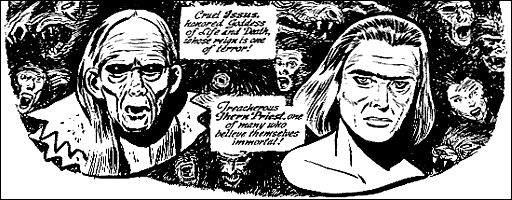 And here is where a group of the White Race of Orovars settled to found
the Religion of Issus. As the seas dried and the Orovars mixed
with the Yellow and Black races to found the Red Race, the population that
found Korus must have been very small. A random mutation for baldness
spread throughout the population and all Therns are now bald. Originally
Auburn-haired, they probably dyed their hair blonde as a sign of their
priesthood as some Christian monks would shave the tops of their heads
to show their devotion to god. Then as they lost their hair, they
replaced the lost locks with blonde wigs. Even Phaidor is bald!
And here is where a group of the White Race of Orovars settled to found
the Religion of Issus. As the seas dried and the Orovars mixed
with the Yellow and Black races to found the Red Race, the population that
found Korus must have been very small. A random mutation for baldness
spread throughout the population and all Therns are now bald. Originally
Auburn-haired, they probably dyed their hair blonde as a sign of their
priesthood as some Christian monks would shave the tops of their heads
to show their devotion to god. Then as they lost their hair, they
replaced the lost locks with blonde wigs. Even Phaidor is bald!
Note: we won't go into pubic hair or lack thereof and the
clothing or lack of that would reveal this.
But watch for my paper on the religion of Issus.
So the once-auburn Orovars became the bald Therns as they spread their
religion across the planet. Obviously, finding the Valley Dor in
the Great Desert of a dying Barsoom must have been like the Promised Land
to them. Perhaps they created or changed the religion to protect
their Valley from invaders? But that is for another paper.
But today, Korus, the origin of Life on Barsoom, may very well be the
last refuge of that life as the eco-system breaks down and Toonol dries
to the point where the Iss ceases to flow and in a few more million years,
Barsoom will be dead…. Save in Korus.

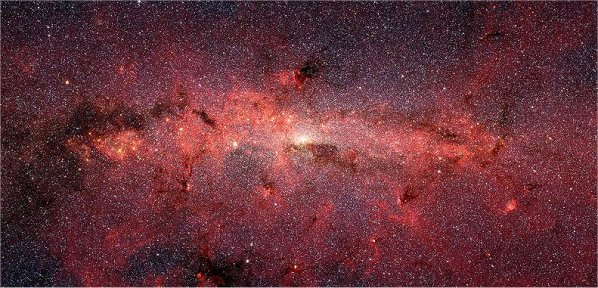


![]()
![]()

![]()